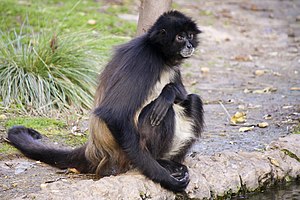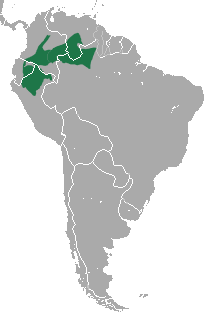White-bellied spider monkey
| White-bellied spider monkey | |
|---|---|
 |
|
| Ateles belzebuth in Buenos Aires Zoo. | |
| Scientific classification | |
| Kingdom: | Animalia |
| Phylum: | Chordata |
| Class: | Mammalia |
| Order: | Primates |
| Family: | Atelidae |
| Genus: | Ateles |
| Species: | A. belzebuth |
| Binomial name | |
|
Ateles belzebuth É. Geoffroy, 1806 |
|
 |
|
| White-bellied spider monkey range | |
The white-bellied spider monkey (Ateles belzebuth), also known as the white-fronted or long-haired spider monkey, is an endangered species of spider monkey, a type of New World monkey. It is found in the north-western Amazon in Colombia, Ecuador, Venezuela, Peru and Brazil, ranging as far south as the lower Ucayali River and as far east as the Branco River. In the past, the Peruvian, brown and white-cheeked spider monkeys have been treated as subspecies of A. belzebuth. As presently defined, the white-bellied spider monkey is monotypic. It has a whitish belly and a pale patch on the forehead, which, despite its common name, often is orange-buff. They live in groups of 20 to 40 individuals, splitting into small parties of 1 to 9 when in activity.
Vernacular names include mono prieto, mico prieto and marimonda (Colombia).
Over the last 45 years (3 generations), the population has declined by approximately 50% due to habitat loss and hunting. Because of this, A. belzebuth is listed as endangered by the IUCN.
White-bellied spider monkeys are important long-distance seed dispersal agents for many fruit-bearing species. They are a dominant disperser for Oenocarpus bataua , a species of palm.A. belzebuth often occupies a large territory and will utilize multiple nesting trees throughout their territory. Seeds of preferred species are often dispersed below sleeping trees.
...
Wikipedia

